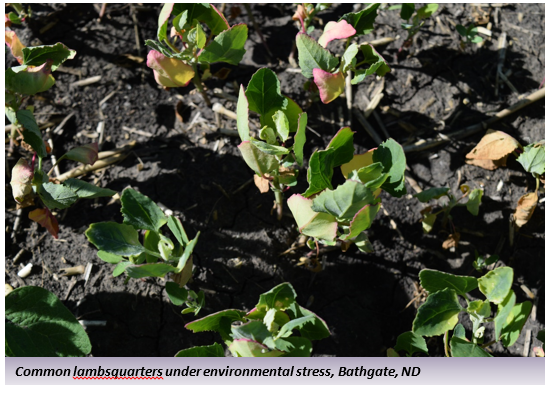Common Lambsquarters Control with Glyphosate is Challenging under Environmental Stress Conditions (06/10/21)
One of my sugarbeet cooperative agriculturalist called and declared he has found a field with glyphosate resistant common lambquarters. Of course, I will investigate. However, I wonder if environmental conditions might explain this observation.
Weeds under environmental stress (to cold, to hot, to dry, to wet) are harder to kill than unstressed plants. Conversely, actively growing weeds are easier to kill weeds with POST herbicides because all biosynethetic processes (photosynthesis, synthesis of amino acids, proteins, and other cellular components, and meristematic growth) are operating at full strength. The negative impacts on plant growth are usually faster and more complete when we disrupt one or more of those processes with a POST herbicide. Now contrast this to a weed growing very slowly, or not at all, due to drought or heat stress. The same physiological processes are occurring but at a very slow rate and symptom development may be very slow and possibly incomplete if there is sufficient time for the herbicide to be metabolized or if it the herbicide does not translocate to other parts of the plant.
What about plant architecture? Drought or heat stress can reduce POST herbicides efficacy by physically changing plant architecture, leaf surfaces, and resultant spray droplet behavior. I have observed droopy leaves or leaves pull together like a tulip, changing the angle at which spray droplets are intercepted when plants are under moisture stress, and leading to a greater proportion of droplets bouncing off the leaf or running off after they are deposited on the surface.
Plants under hot and dry conditions produce a thicker cuticle with a higher proportion of waxy constituents. The plant cuticle functions to reduce losses to evaporation; however, it also functions as a barrier to the spray droplets applied to the leaf surfaces. Dry conditions can greatly impact the spray droplet performance itself. Droplets are subject to evaporation between the time they leave the spray nozzle and being absorbed by the leaf surface – this is much more dramatic under hot, low humidity conditions. In addition, the droplets may dry very quickly once they are on the leaf surface, leaving insufficient moisture to facilitate absorption of the herbicide into the plant.
I recommend going back to ‘weed science basics’ including using the highest labeled herbicide rate for a crop growth stage or weed size, being absolutely sure of the acid equivalent of the herbicide (glyphosate) formulation, and adjuvant loading, and optimizing adjuvant and adjuvant properties with herbicide and weed target. Finally, if you have flexibility, consider time of day when herbicides are applied. For example, morning applications when humidity is higher and temperature is lower as compared to afternoon or evening applications since weed targets are more hydrated.

Extension Sugarbeet Agronomist
NDSU & U of MN


